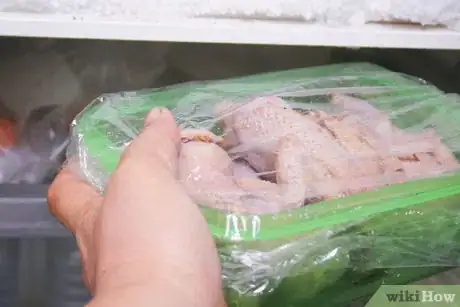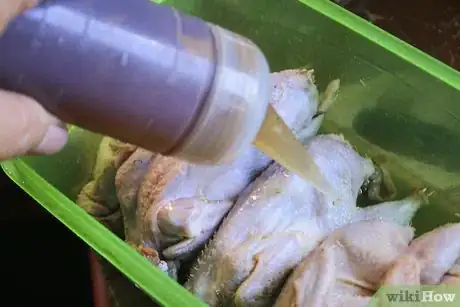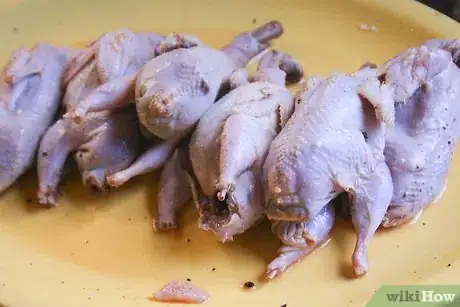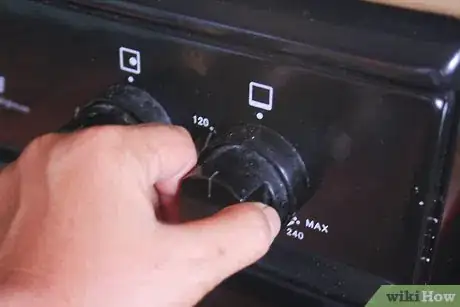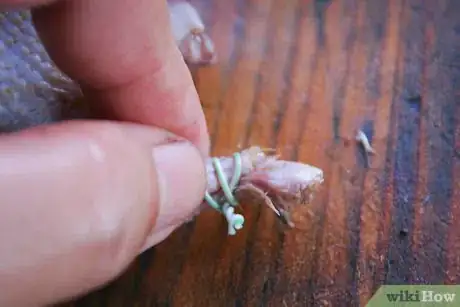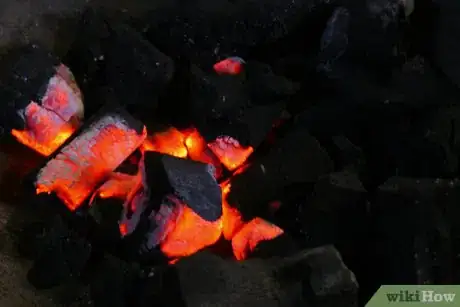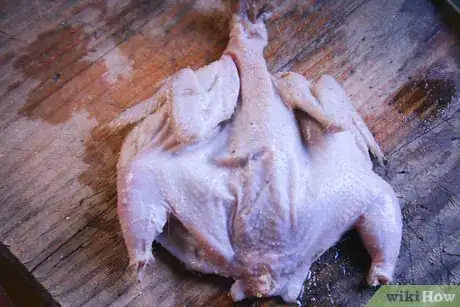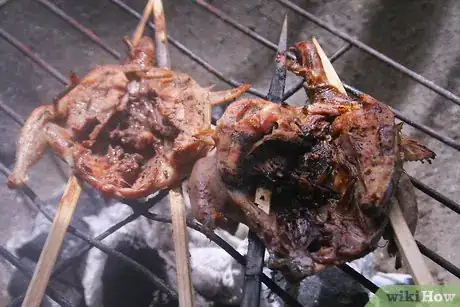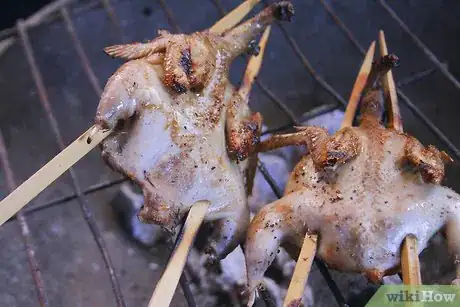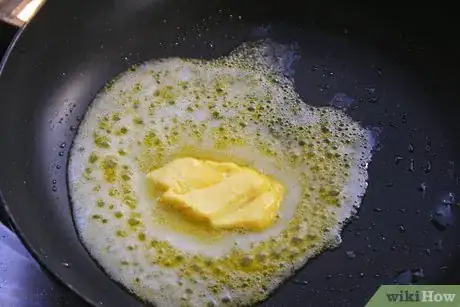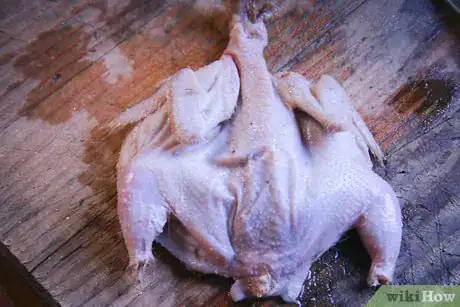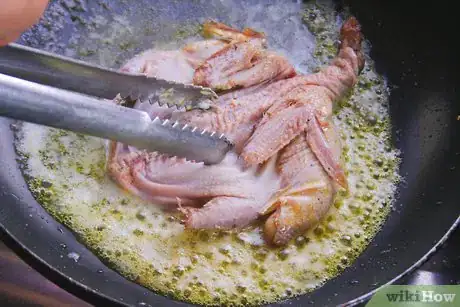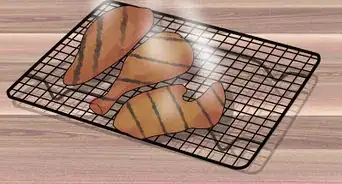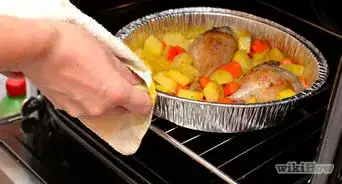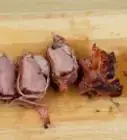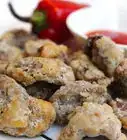wikiHow is a “wiki,” similar to Wikipedia, which means that many of our articles are co-written by multiple authors. To create this article, volunteer authors worked to edit and improve it over time.
This article has been viewed 107,156 times.
Learn more...
Cook quail by roasting it in the oven, grilling it, or sauteeing it on the stovetop. Its lean meat can dry out quickly, so you'll need to carefully monitor its progress regardless of which cooking method you use.
Ingredients
Makes 2 servings
- 4 whole quail
- 4 Tbsp (60 ml) butter or olive oil
- 1 tsp (5 ml) salt
- 1/2 tsp (2.5 ml) ground black pepper
Optional Marinade
- 3 Tbsp (45 ml) olive oil
- 1/2 tsp (2.5 ml) minced garlic
- 1 tsp (5 ml) chopped fresh thyme
- 1 tsp (5 ml) chopped fresh sage
- 1 tsp (5 ml) chopped fresh parsley
Optional Brine
- 1/4 cup (60 ml) kosher salt
- 4 cups (1 L) white wine or water
- 4 bay leaves
Steps
Before You Begin: Preparations
-
1Choose plump, unblemished quail. When purchasing quail from the store, choose birds that appear relatively plump since they'll have a better ratio of meat to bone. Make sure that the skin appears unblemished, too.[1]
- Additionally, the quail skin should look creamy or yellow with a slight pink tint.
- Do not purchase quail that looks dry or smells peculiar.
- Note that quails can be purchased bone-in, semi-boneless, or fully boneless. Any of these options can be used.
-
2Use the quail within two or three days. Store fresh quail in the refrigerator and use it within two or three days.
- Cover a tray or baking sheet with greaseproof wax paper or parchment paper, then put the quail on top. Keep it on the bottom shelf of the refrigerator so that no juices can drip off and contaminate other foods.
Advertisement -
3Marinate or brine the quail, if desired. You don't need to marinate or brine the quail, but since the meat is lean and fairly dry, doing so can reduce the risk of drying the meat out during the cooking process.
- For a simple marinade:[2]
- Combine the olive oil, garlic, thyme, sage, and parsley in a large glass bowl.
- Add the quail to the bowl and toss to coat thoroughly.
- Cover the bowl with plastic wrap and refrigerate the quail for two hours.
- For a simple brine:[3]
- Combine the wine/water, salt, and bay leaves in a small saucepan. Bring the mixture to a boil on the stove over medium-high heat.
- Allow the brine to cool.
- Place the quail in a large bowl and cover with the brine. Cover with plastic wrap, then refrigerate for two hours.
- For a simple marinade:[2]
-
4Bring the quail to room temperature before cooking it. Remove the quail from the refrigerator roughly 30 minutes to one hour before you plan on cooking it. Keep it on the counter, away from cooked foods or foods that will be eaten raw.
- Keep the quail on its tray or in its bowl as it drops to room temperature. Clean the counter both before and after setting the quail on top to minimize the risk of contamination.
- During this time, you should also drain any brine or marinade, then pat the outside and inner cavity using clean, undecorated paper towels or parchment paper. The surface should appear moist but not soaking wet.
Method One: Roasted
-
1Preheat the oven to 350 degrees Fahrenheit (180 degrees Celsius).[4] Prepare a small roasting pan or baking dish by lightly coating it with nonstick cooking spray.
- Alternatively, line the pan with aluminum foil or parchment paper for an easier clean-up.
-
2Tie the legs together. Pull the legs together over the back of the quail, then tie them in place using clean kitchen twine.
- By tying the legs together, you can help the quail remain steady as it cooks. If you do not tie the legs together, you may need to use celery sticks or skewers to help stabilize them after placing the birds in your baking pan.
-
3Season the quail. Coat the surface of the quail with melted butter or olive oil, then rub the salt and pepper over all sides of each quail.
- Use a pastry brush to evenly coat the birds with the butter or oil. Also note that the quail will brown best if you use melted butter.
- While not necessary, you can also stuff the inner cavity of the quail when you choose to roast it. Fruit-based stuffing tends to work best, especially when it makes use of plum or prune flavors.
-
4Roast for 15 to 20 minutes. Place the quails breast-side down in your prepared pan and transfer them to your preheated oven. Cook for 15 to 20 minutes, or until the meat feels slightly firm and the juices run clear.
- If you choose to stuff the quail, you will need to increase the overall cooking time by 10 to 15 minutes.
-
5Enjoy. Remove the quail from the oven and allow it to rest for 5 to 10 minutes. Serve while still hot.
- Consider placing a loose aluminum foil tent over the birds as they rest. Doing so traps more heat inside and may allow the juices to distribute more evenly.
- If desired, you can serve the quail with lemon juice, wild game sauce, or other similar condiments.
Method Two: Grilled
-
1Preheat the grill. Preheat a gas or charcoal grill, preparing separate areas for direct and indirect heat.
- If using a gas grill, turn on two sets of burners (the front and rear or the left and right) to medium-high heat. Leave the middle burner off.
- If using a charcoal grill, position piles of hot coals on each side of the grill but leave the middle section clear.
-
2Spatchcock the quail. Remove any ties and cut out the backbone of each quail using sharp kitchen scissors. Use your hand to push down along the length of body until it lies flat.
- Keep the quail flat as it cooks by inserting two skewers along the width of the body. Both skewers should go through both legs.
-
3Season the quail. Coat the quails with olive oil or melted butter, then rub the surface of each with salt and black pepper.
- When grilling the quail, the skin should brown easily regardless of whether you use butter or oil. Either way, however, you should distribute the fat evenly over all sides of the bird using a basting brush or spoon.
-
4Brown the first side. Place each quail breast-side down on the hot side of the grill. Cook the quails for 3 to 4 minutes, or until the first side is thoroughly browned.
- Avoid turning, flipping, or otherwise moving the birds as they brown. You'll need to keep them relatively still to adequately sear in the juices.
-
5Brown the second side. Flip the quails to the back-side and cook for an additional 3 to 4 minutes, allowing this other side to brown, too.
- Note that the quail should still be positioned over the hot side of the grill during this step.
-
6Cook 10 to 12 more minutes over indirect heat. Once both sides are browned, move the birds to the middle or indirectly heated section of the grill. Continue cooking them for 10 to 12 minutes, or until the meat feels slightly firm and the juices run clear.
- Keeping the grill lid closed during this time will hold in more heat.
- You should be able to rotate and flip the quails over as they cook during this step without disrupting the cooking process.
-
7Enjoy. Remove the cooked quails from the grill and let them rest for 5 to 10 minutes before serving.
- Transfer the birds to a serving dish and place a loose tent of aluminum foil over them. The foil should help the quails retain more heat as the juices settle and distribute themselves.
- Quail can be served with wild game sauce or lemon juice, if desired.
Method Three: Sauteed
-
1Melt the butter in a heavy skillet. Place a medium to large skillet on the stove. Add the butter, then turn the heat to high.
- Preheat the skillet until the butter melts. Turn the skillet periodically to evenly distribute the melted butter over the inner surface.
- You can use olive oil instead of butter for a healthier option. Heat the oil for at least 30 to 60 seconds before continuing. The oil should be hot, but it should not be hot enough to produce smoke.
-
2Spatchcock the quail. Use kitchen scissors to cut out the backbone of each quail. Push down on the back of the bird, working along the length of the body, until it lies flat.
- Insert two skewers along the width of each quail to help it remain flat during the cooking process. Each skewer should go through both legs of the quail.
-
3Season the quail. Evenly rub both sides of the birds with salt and pepper.
- Note that you do not need to brush the quails with butter or oil when using this method. There should already be plenty of fat in the skillet.
-
4Brown one side. Place both quails, breast-side down, in the hot skillet. Cook them for 4 to 5 minutes or until the breast-side browns.[5]
- Do not rotate, flip, or otherwise move the quails during this step. They should remain relatively undisturbed so that this side browns well.
-
5Flip and continue cooking. Use tongs to flip the quails over to their back-sides. Continue cooking for another 4 to 5 minutes or until the birds feel firm and tender. The juices should also run clear.
- After flipping them, spoon some of the hot butter or oil over the newly exposed sides of each quail.
- Do not turn or rotate the birds as they finish cooking. You can, however, spoon additional butter over them to minimize the risk of drying out the meat.
-
6Enjoy. Transfer the quails to a serving plate, then pour the pan drippings on top. Allow the meat to rest for 5 to 10 minutes before serving.
- Form a loose tent with aluminum foil and place it over the resting quails. Doing so should allow them to retain more heat, so the juices can be redistributed without the meat cooling down too much.
- Serve the quails with their pan drippings, or prepare a separate wild game sauce. Quails also taste great with lemon juice.
Community Q&A
-
QuestionMy friend cooked quail, but didn't realize you had to gut them. Can they still be eaten?
 Community AnswerProbably not, due to the waste still being in the bird. It would not be the best idea, someone could get sick.
Community AnswerProbably not, due to the waste still being in the bird. It would not be the best idea, someone could get sick.
Things You'll Need
Preparations
- Baking sheet or tray
- Greaseproof paper (wax paper or parchment paper)
- Large bowl (optional)
- Plastic wrap (optional)
- Paper towels
Roasted
- Small roasting pan or baking dish
- Nonstick cooking spray, nonstick aluminum foil, or parchment paper
- Kitchen twine
- Pastry brush
- Aluminum foil
Grilled
- Kitchen scissors
- 4 skewers
- Basting brush or spoon
- Grill tongs
- Serving dish
- Aluminum foil
Sauteed
- Medium to large skillet
- Kitchen scissors
- Spoon
- Tongs
- Serving dish
- Aluminum foil
References
- ↑ http://www.bbcgoodfood.com/glossary/quail
- ↑ http://www.fieldandstream.com/blogs/hunting/2010/03/recipe-perfect-grilled-quail
- ↑ http://honest-food.net/wild-game/pheasant-quail-partridge-chukar-recipes/roast-quail/
- ↑ http://www.brokenarrowranch.com/Recipes/Quail-Cooking-Tips.htm
- ↑ http://texquail.com/recipe/sauteed-semi-boneless-quail
About This Article
To cook quail in the oven, start by tying the quail's legs together with kitchen twine so the bird stays steady as you cook it. Then, brush the quail with oil or melted butter, and season it with your favorite spices. Next, place the quail breast-side down in a greased baking pan. Finally, roast the quail in the oven for 15-20 minutes at 350 degrees Fahrenheit, or until the meat is firm the juices run clear. To learn how to grill and saute quail, scroll down!

